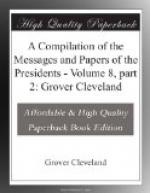The desire of full and ample illustration, which has actuated both parties, has led to the search among neglected archives for documents almost innumerable, and their force and bearing upon the question have been exhibited in arguments of great ability. Such has been the talent shown in this task of illustration and so copious have been the materials employed for the purpose that the great and only important question, although never lost sight of by the writers themselves, has to the eye of the casual observer been completely hidden. In the report under consideration this distinction between treaties of binding force and documents intended for mere illustration has not been regarded, and the vague as well as obviously inaccurate delineations of a French or a Venetian map maker are gravely held forth as of equal value for a basis of argument as the solemn and ratified acts of the two nations.
In pursuance of this desire of illustration, every known document which could in any form support either claim has been advanced and set forth in the statements laid before His Majesty the King of the Netherlands when acting as umpire under the fifth article of the treaty of Ghent. If not yet given entire to the public,[39] they are in the possession of both Governments in a printed form, together with the opinion of the arbiter in respect to them; and although it is necessary that the arguments then adduced in favor of the American claim should be in part repeated, and although new illustrations of the correctness of that argument have since been brought to light, the present document will be confined as closely as possible to the provisions of the treaty itself, and will adduce no more of illustration than is barely sufficient to render the terms of that treaty certain and definite.
[Footnote 39: A considerable part of the papers, together with the argument, has been published by Mr. Gallatin in his Right of the United States to the Northeastern Boundary. New York, 1840. 8 vo. pp. 180.]
The boundaries of the United States are described in the treaty of 1783 in the following words:[40]
[Footnote 40: The words here appearing in italics are not italicized in the original treaty.]
“And that all disputes which might arise in future on the subject of the boundaries of the said United States may be prevented it is hereby agreed and declared that the following are and shall be their boundaries, viz: From the northwest angle of Nova Scotia, viz, that angle which is formed by a line drawn due north from the source of St. Croix River to the highlands; along the said highlands which divide those rivers that empty themselves into the river St. Lawrence from those which fall into the Atlantic Ocean to the northwesternmost head of Connecticut River; thence down along the middle of that river to the forty-fifth degree of north latitude; from thence by a line due west on said latitude until it strikes the river Iroquois,




